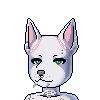
First in a series of five I'm planning. Sorry, it's not exactly furry. Painted in watercolor and gouache on 12"x18" hot press.
Category Artwork (Traditional) / Fantasy
Species Unspecified / Any
Size 1280 x 853px
File Size 89.6 kB
I combine both transparent watercolors and gouache when I'm painting. I actually find gouache MUCH easier to work with than traditional watercolor in a LOT of ways. It tends to behave much more like tempera. There are some great effects you can only get with transparent watercolor, though, so I like to mix it up.
Color blending IS tricky. There are a couple things you can do to make it work better.
1. "Blend down, blend up" by which I mean, when you know you want to do a gradient from one distinct color to another, start by using a dry-brush/semi dry-brush technique to blend the first color "down" to paper at the transition, and then, when you apply the second color, blend it "up" from solid to thin over the transition of the first color. As with pretty much all watercolors, dark goes better over light, but can sometimes work the other way as well... slightly different look. Do some practice blends in 2x2 squares to see how different colors behave.
2. Similar to above. When doing tone to tone, it's sometimes better to blend paint on a palette and do a couple blended stages as per above. Note: mixing with white is tricky and will most often dry darker than you intended. I generally use white not to mix but to overpaint to lighten the color underneath (see abs above).
3. Above all, with ALL watercolor, get used to the "gesture" and explore a bit what the paint wants to do naturally and learn to exploit that. If you look at the ground shadow you can see where I used some plain old water techniques to create some interesting textures. It's very zen/tao... oils and acrylics tend to be very plastic and easy to bend to the will of the painter... watercolor and gouache... not so much. But if you can "flow" with that, it's a very rewarding medium. Just don't expect them to look like an acrylic painting.
(Gah... Sorry about the ramble. I used to be a teacher and my teaching hat still comes out sometimes. And I LOVE to talk technique.)
1. "Blend down, blend up" by which I mean, when you know you want to do a gradient from one distinct color to another, start by using a dry-brush/semi dry-brush technique to blend the first color "down" to paper at the transition, and then, when you apply the second color, blend it "up" from solid to thin over the transition of the first color. As with pretty much all watercolors, dark goes better over light, but can sometimes work the other way as well... slightly different look. Do some practice blends in 2x2 squares to see how different colors behave.
2. Similar to above. When doing tone to tone, it's sometimes better to blend paint on a palette and do a couple blended stages as per above. Note: mixing with white is tricky and will most often dry darker than you intended. I generally use white not to mix but to overpaint to lighten the color underneath (see abs above).
3. Above all, with ALL watercolor, get used to the "gesture" and explore a bit what the paint wants to do naturally and learn to exploit that. If you look at the ground shadow you can see where I used some plain old water techniques to create some interesting textures. It's very zen/tao... oils and acrylics tend to be very plastic and easy to bend to the will of the painter... watercolor and gouache... not so much. But if you can "flow" with that, it's a very rewarding medium. Just don't expect them to look like an acrylic painting.
(Gah... Sorry about the ramble. I used to be a teacher and my teaching hat still comes out sometimes. And I LOVE to talk technique.)

 FA+
FA+














Comments